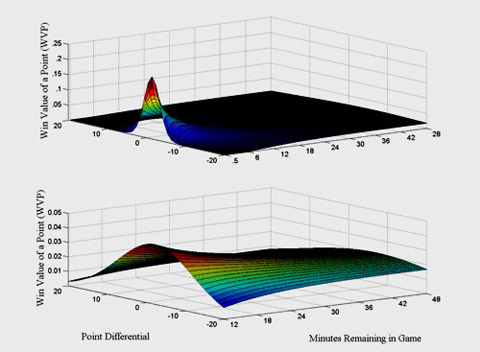"You basically brought Yoda to this conference," Simmons later told Morey. "People are just staring at him like he's a mountain or volcano or something."
But while it might have been Moneyball's year at the box office, even James had to admit that the most exciting analytics work is now being done in basketball, which is experiencing its own Big Data moment. A handful of teams are implementing a new system that tracks player and ball movement in three dimensions, in intricate detail, in real time — producing a data set that is quickly revolutionizing the sport.
Away from the bright lights of the ballroom stage, the Sloan conference's real attractions — the future economists, engineers, and scientists who will form the next generation of high-end sports analysts — were already extracting new insights. A team of computer scientists from USC showed how they'll be able to rate rebounders based not merely on box-score numbers but on their positioning immediately before, during, and after shot attempts. A scientist at Yahoo! Research Labs teamed up with a UC-San Diego economics grad student to figure out how to quantify clutch free-throw shooting. Kirk Goldsberry, an assistant professor of geography at Michigan State (and visiting scholar at Harvard), answered the question, "Who is the NBA's best shooter?" by ignoring overall field-goal percentage— which turns out not to be very helpful — and instead finding the players who, like Ray Allen, make the highest percentage of shots from the most locations on the court. (Allen, it turns out, is the league's second-best shooter; the best is Steve Nash.) If for some reason NBA teams are uninterested in Goldsberry's rainbow-hued heat-maps of the league's top marksmen— showing not only the strong points of Dirk Nowitzki's game but also the cold mid-range valleys that an opposing team might want to force him into — there's probably a market for the visualizations as stat-boy dorm-room posters.
 |
KNOWLEDGE IS POWERThe two most radical ideas proposed at the Sloan conference had nothing to do with regression analysis, and were advanced not by the top management who attended, nor by the legions of extraordinarily smart stat-geeks who came in the hopes of impressing them, but instead by a retired comedian and a lowly journalist for the Economist, respectively. The comedian, Drew Carey, who is also an owner of Major League Soccer's Seattle Sounders, proposed that the jobs of high-profile franchise managers should be subject to direct democracy — an idea that made several of those high-profile franchise managers visibly nervous.
Carey said he'd been influenced by Spanish soccer, where several clubs allow season-ticket holders to elect the club president every four years. The Sounders, who are experiencing record attendance, don't go that far — but they do allow season-ticket holders to fire the GM. (Middle management took it on the chin all weekend— several people, including Morey, agreed that coaches were probably fired too much, and GMs not enough.) Paraag Marathe, the COO of the San Francisco 49ers, made a predictable argument: that in a shallow market for managers, the top talent would never take a job that they could be voted out of. Carey was insistent: "I would never hire a salesman who won't work on commission."